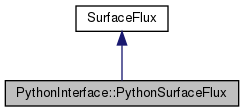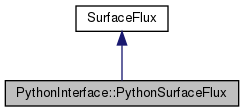Use a python function to evaluate the surface flux. More...
#include <PythonInterface.H>


Public Member Functions | |
| PythonSurfaceFlux (const std::string &a_pyModule, const std::string &a_pyFunc, std::map< std::string, Real > &a_kwarg) | |
| Construct a PythonSurfaceFlux from module, function, and kwargs list. More... | |
| virtual | ~PythonSurfaceFlux () |
| virtual SurfaceFlux * | new_surfaceFlux () |
| factory method: return a pointer to a new SurfaceFlux object More... | |
| virtual void | surfaceThicknessFlux (LevelData< FArrayBox > &a_flux, const AmrIceBase &a_amrIce, int a_level, Real a_dt) |
| define source term for thickness evolution and place it in flux More... | |
 Public Member Functions inherited from SurfaceFlux Public Member Functions inherited from SurfaceFlux | |
| virtual | ~SurfaceFlux () |
| virtual destructor More... | |
| virtual void | evaluate (LevelData< FArrayBox > &a_data, const AmrIceBase &a_amrIce, int a_level, Real a_dt) |
| Sub-classes of this class turned out to be useful for various data apart from thickness fluxes... More... | |
Additional Inherited Members | |
 Static Public Member Functions inherited from SurfaceFlux Static Public Member Functions inherited from SurfaceFlux | |
| static SurfaceFlux * | parse (const char *a_prefix) |
| assemble a SurfaceFlux* object from ParmParse inputs More... | |
Detailed Description
Use a python function to evaluate the surface flux.
The user needs to provide a python function foo that takes x,y,thickness,topography as args, plus some kwargs and returns a single scalar (the flux)
Run-time configuration is carried out in SurfaceFlux::parse. If the string A.B.C.type = pythonFlux is found, then the expected form is:
A.B.C.module = <string>(the name of the python module, eg.foo(notfoo.py)A.B.C.function = <string>(the name of the python function infoo)A.B.C.n_kwargs = <int>(the number of keyword arguments)A.B.C.kwargs = <string> <string> ...(the keywords)
Keywords supported are: gl_proximity, gl_proximity_scale. In each case, BISICLES supplies a known value, serived from the ice sheet state, if a known keyword is supplied
Constructor & Destructor Documentation
◆ PythonSurfaceFlux()
| PythonInterface::PythonSurfaceFlux::PythonSurfaceFlux | ( | const std::string & | a_pyModule, |
| const std::string & | a_pyFunc, | ||
| std::map< std::string, Real > & | a_kwarg | ||
| ) |
Construct a PythonSurfaceFlux from module, function, and kwargs list.
- Parameters
-
a_pyModule the python module name a_pyFunc the python function name a_kwarg a list of kwarg names
References PythonInterface::InitializePythonFunction(), PythonInterface::InitializePythonModule(), and PythonSurfaceFlux().
Referenced by PythonSurfaceFlux().
◆ ~PythonSurfaceFlux()
|
virtual |
Member Function Documentation
◆ new_surfaceFlux()
|
virtual |
factory method: return a pointer to a new SurfaceFlux object
Implements SurfaceFlux.
Referenced by SurfaceFlux::parse().
◆ surfaceThicknessFlux()
|
virtual |
define source term for thickness evolution and place it in flux
- Parameters
-
a_flux output flux data a_amrIce reference to the ice sheet state a_level mesh level of a_flux a_dt current timestep
a_dt is included in case one needs integrals or averages over a timestep. flux should be defined in meters per year in the current implementation.
Implements SurfaceFlux.
References PythonInterface::FillKwargs(), AmrIceBase::geometry(), PythonInterface::PythonEval(), and AmrIceBase::time().
The documentation for this class was generated from the following files:
 1.8.13
1.8.13